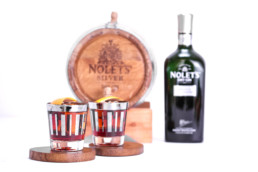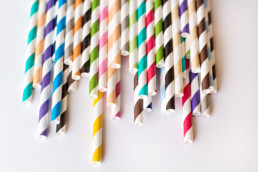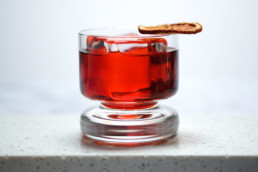Month: July 2019
Barrel Aged
The process of aging a high-octane cocktail in a flavorful oak barrel imparts a complex and cohesive element, along with a woody undertone. As the alcohol interacts with the wood, something scientific (and magical) happens, flavorful compounds emerge in tannins and vanillins that mature as they age. The result is a pre-mixed cocktail with unique depth, perfect for a bar/restaurant or a home bartender. Memorable for a party or event, the process is not too complicated for the return on investment.
The quality and alcohol content of the cocktail to be barrel aged must be high, and the output will be exceptional, imparting a mild oak flavor that mellows the alcohol and acidity. Spirits that are pot distilled have a unique character that is naturally enhanced by aging in an oak barrel. Barrels come in various sizes and can last for multiple uses if cared for properly.
So, get a barrel and follow the directions below.
BARREL PREP
To prepare a new barrel for aging, there are a few things you’ll need to do. The barrel will be sanitary because the wood was heated to bend the staves into place. Fill the barrel with water to cause the wood swell and eliminate possible leaks (this could take several hours or a couple of days). If leaking persists, beeswax on the outside of the dry barrel will seal cracks. (Never put beeswax on the inside of the barrel, as it will contaminate the liquor on the inside).
After the swelling occurs, simply rinse the barrel of any sawdust. At this stage, measure the amount of liquid it holds to maximize the amount of product that fits inside for proportions.
The cocktail you choose to make should be sweetened only with liqueur. Sweetening agents (sugar, simple syrup, molasses or honey) or fresh ingredients (such as citrus juice) will oxidize or ferment, which would ruin the whole batch. Use bitters sparingly so that they don’t overpower the cocktail inside the barrel.
Combine the spirits.
Store the barrel in a dark, cool place. You’ll want to try a sip every few days. New barrels will take less time to age the contents. Once the cocktail has rested and tastes ready, strain into a clean glass container for storage. The barrel will then need to be thoroughly cleaned and rinsed with a Citric Acid wash (dissolve two teaspoons of citric acid in five gallons of water, swish mixture around for 5-10 minutes, flush thoroughly and refill). After using, the barrel should be stored filled with liquid, if not aging liquor, water that is replaced every two weeks.
RECIPES
NOLET’S Silver Barrel Aged Negroni
1 part NOLET’S Silver Gin
1 part Sweet Vermouth
1 part Aperol
Batch ingredients together and pour into a drained, clean barrel. Allow resting for 2-3 weeks. Strain into a clean glass container to store.
Cocktail Prep: Pour 3 oz. into a mixing glass with ice. Stir then strain into a Coupe or double Old-Fashioned glass. Garnish with an orange twist.
NOLET’S Silver Barrel Aged Martinez
2 parts NOLET’S Silver Gin
2 parts Sweet Vermouth
1 part Maraschino Liqueur
¼ part Angostura Bitters
Batch ingredients together and pour into drained, clean barrel. Allow resting for approximately 2-3 weeks (tasting every several days).
Cocktail Prep: Pour 3 oz. into a mixing glass with ice. Stir then strain into a Coupe glass. Garnish with an orange twist.
NOLET’S Silver Barrel Aged Manhattan
2 parts NOLET’S Silver Gin
2 parts Sweet Vermouth
¼ part Orange Bitters
Batch ingredients together and pour into drained, clean barrel. Allow resting for approximately 2-3 weeks (tasting every several days).
Cocktail Prep: Pour 3 oz. into a mixing glass with ice. Stir then strain into a Coupe glass. Garnish with maraschino cherry.
The Last Straw
Beginning with the astute observation of a young man, the ubiquitous ban on plastic straws is embraced fully by food and beverage companies, consumers and activists alike. The ban and vilification of single-use plastics are supported and promoted by conservationists, social media campaigns and celebrities who are all working to reduce unnecessary waste. As the most collected object of beach cleanups, and the culprit damage to marine life, the once innocuous straw is now the number one utensil non grata.
Americans use 500 million straws a day (1.6 straws per person) according to the National Park Service. Those straws, made of polypropylene resin, take 200 years to break down, and when they do, become tiny toxic plastic particles.
In 2011, when the then 9-year-old Milo Cress in Burlington Vermont asked the burger joint he frequented to “offer first”, noticing many people didn’t use the straws automatically served. He said, “It seemed like a waste to me.” From that, Milo created BEStrawFree.org, and now, years later, is witnessing overwhelming support in the banning straws, suggesting alternatives to plastics and raising awareness to the problems with single-use plastics.
Number 5 is the recycling code for polypropylene, and although it is the most valuable and recycled plastic around, the demand and recycling potential of straws is minimal because they’re lightweight fitting perfectly into small spaces like storm drains and they literally slip through the cracks at recycling facilities. When straws end up in landfills and wash into the ocean they cause damage to sea creatures both directly and indirectly. The heartwrenching YouTube video of the straw being removed from a Sea Turtle’s nose has had close to 33 million views. According to Greenpeace, “plastic has been found in the stomachs of one in three sea turtles”.
The social media component, #StopSucking #breakFreeFromPlastic, #refusethestraw, and #ditchthestraw along with the support of celebrities like Tom Brady, Neil deGrasse Tyson and Tim Robbins (narrating a documentary befittingly called “Straws”) who use their platform to educate and raise awareness to the impact plastics have on our environment. The UN Environmental Programme’s goodwill ambassador, actor and activist Adrian Grenier believes that straws are “a gateway” that will hopefully lead to the alleviation of other plastics.
There are many viable alternatives to single-use plastic straws, like compostables or a plethora of multi-use sipping variants made of bamboo, seaweed, paper, straw, aluminum, titanium, silicone, and glass. In a restaurant and bar setting, these options are better for the environment and ultimately save money over time. This initiative is embraced by companies large and small in both city and state initiatives. In the effort of minimizing the environmental impact, Global Sustainable Development Director of Diageo adds that “When the use of straws is important to the enjoyment of our brands we will only use reusable, compostable or biodegradable alternatives.” This movement shows no sign of waning, especially for the environmentally conscious drinker.
Clearly, It’s Time To Clean Up Your Ice
Participating in the cocktail revolution requires mixing the finest spirits crafted with fresh ingredients, assembled with stunning bar tools, and served in memorable glassware. Too bad the ice from the freezer is destroying your cocktails. As we enjoy the cocktail revival and all the beautiful and creative aspects of the culture of imbibing, the trickiest element in the modern cocktail is the ice. Freezer ice is not only ugly, but it’s flavor polluting. Inferior cubes melt rapidly and ultimately dilute and degrade the exceptional ingredients expertly combined. Fear not, there are several practical solutions to this quandary.
Making clear, tasteless ice blocks at home is not straightforward, and although possible (we’ll get to that), there are natural “first-steps” to take in shattering the ice conundrum. The science of freezing in a home freezer is this; as water freezes, it begins forming ice on the surface, trapping impurities and bubbles within the cube resulting in a cloudy cube that is not completely solid. Murky, porous cubes melt faster, compromising both the quality and taste of the beverage they’re cooling.
Too bad the ice from the freezer is destroying your cocktails.
In-freezer ice-maker ice takes on the flavor of the freezer in which it lives. Diligence and a couple of easy hacks can fix that. First, it’s essential to keep it clean, with sealed food containers, rotation of contents, and a box of baking soda, for good measure. Change the water filter regularly. If you’re not using a high volume of ice, and it sits more than a day, dump and replenish often to keep it fresh. It’s a good idea to store newly made ice in a sealed freezer bag to keep it fresher longer. If you’re making your own ice cubes, you want them to be as solid and transparent as possible. The best hack is to double boil your water. Using distilled water, boil it, let it cool, and boil it again before freezing. This removes impurities and bubbles.
Ice cube trays have a host of problems, and to be clear, the only solid option for trays is the classic aluminum type because they’re nonporous. Plastic and silicone trays take on the aroma of the freezer they’re stored in and transfer that flavor to the ice. The smell never comes out. Plastic trays can leach both chemicals and flavor into the ice. Novelty cubes from silicone molds are a decent option as long as they’re used correctly. The best method is to freeze the cubes, unmold them promptly, store the ice, and wash the molds with warm soapy water and a touch of white vinegar. Store the molds in a cabinet, not the freezer.
After testing several “clear cube” devices made for home mixologists, we obtained some decent results. Using distilled, double-boiled water in an insulated cooler with approximately 3” of water, freeze uncovered for 8-10 hours, score the ice and cut into blocks with a pick and a sharp knife (and gloves, of course). Shaping the cubes will take practice, but the ice will be dense and clear. The cooler takes up a substantial real estate in the freezer; if that’s an issue, there are commercial insulated 4-square block ice makers that also work well. Using the same water process, you can achieve a mostly clear block that may require a little shaving of bubbles off one side.
It’s a good idea to store newly made ice in a sealed freezer bag to keep it fresher longer.
If DIY is not your thing, there are many clear “gourmet” ice makers on the market in under-counter and stand-alone style machines that produce clear ice chips or small blocks akin to an average bar or restaurant. There are also tabletop systems that produce clear ice “slugs” that can be molded into ice spheres or blocks. These solutions can be costly; however, they deliver a consistent product worthy of a luxury beverage. For special occasions and entertaining, an ice delivery service is a solid option. Available in most areas, an ice service will not only provide shapes that the glassware requires, but also can create personalized messages and custom elements.
Finally, choose your shape, sphere, cube, chip or shard in harmony with cocktail and vessel. This should render a solid ice game for any home mixologist, complementing the beauty of the tipple being served.




